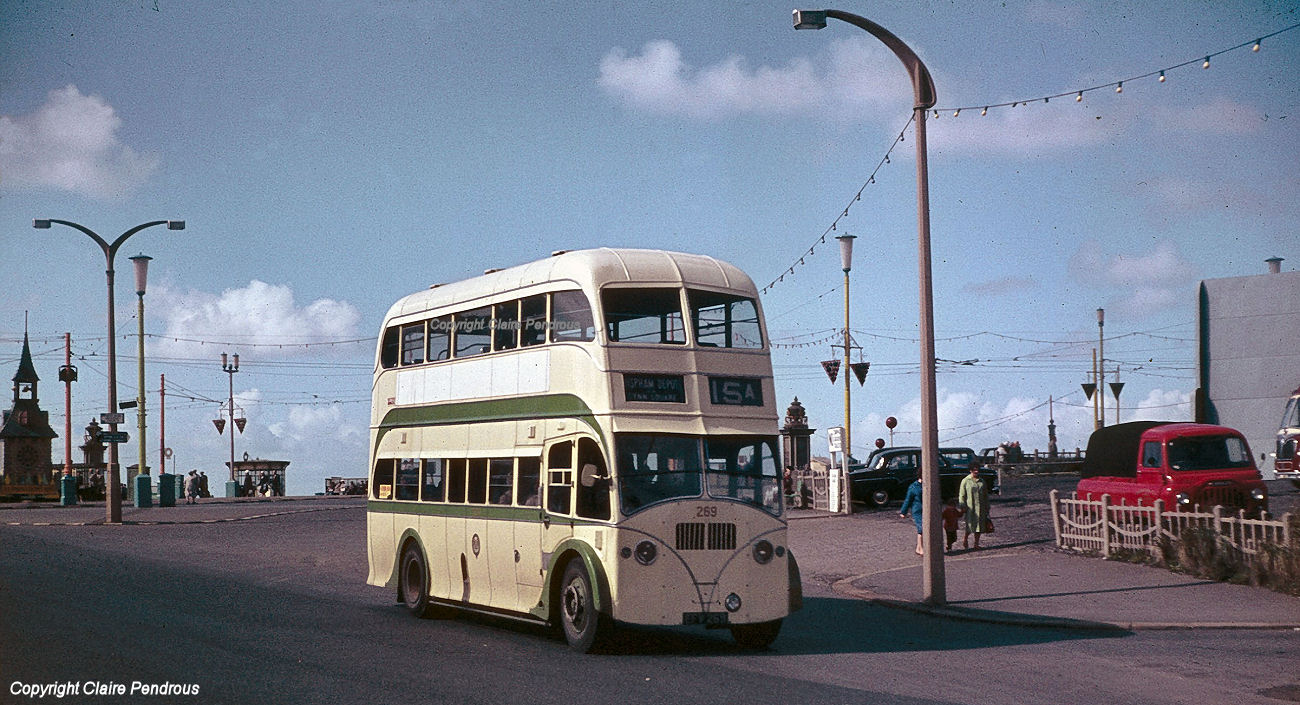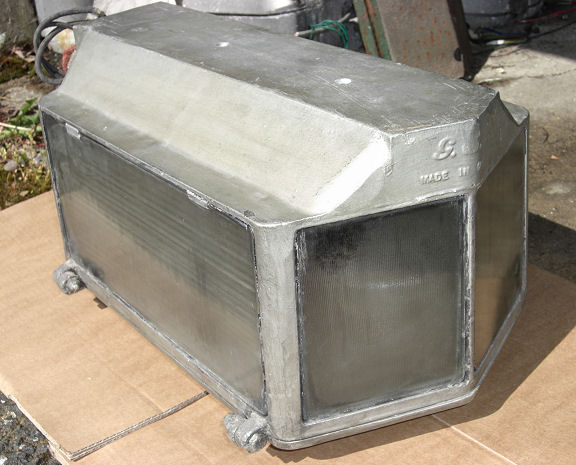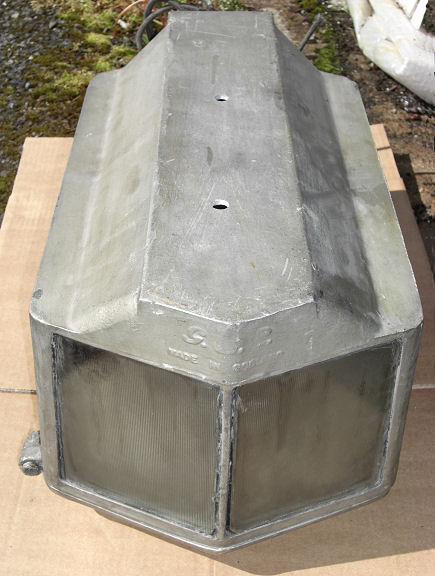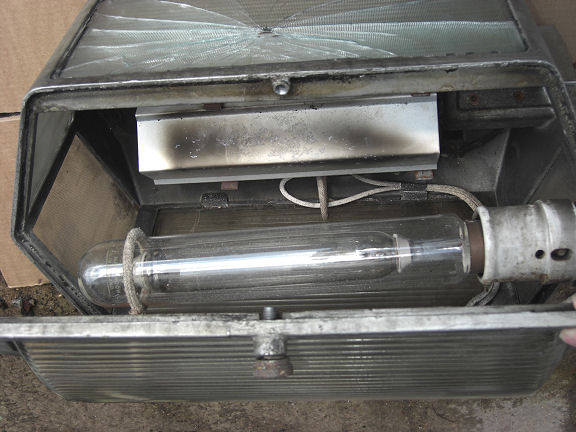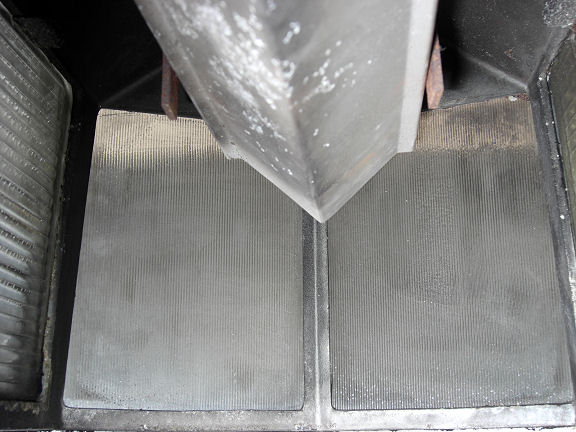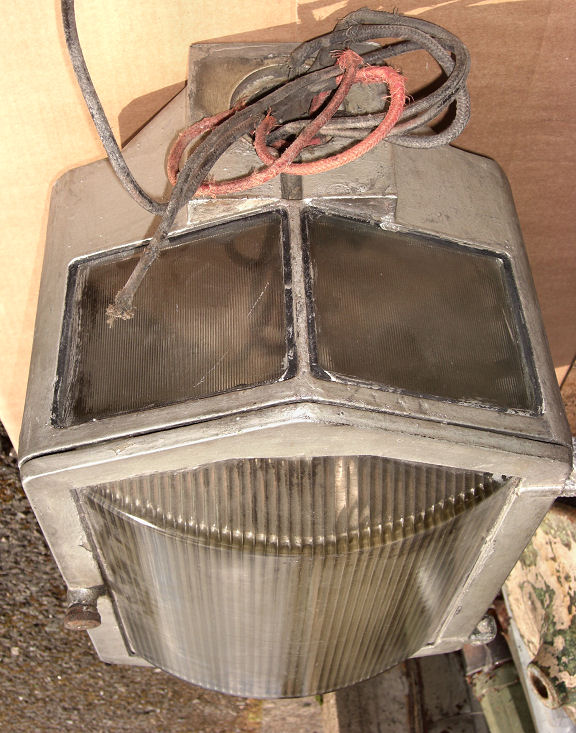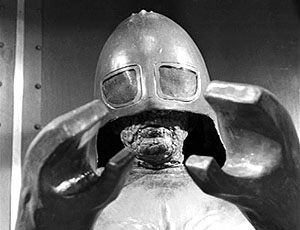GEC Z8432 'Viatron'
250w-400w MA-H lantern
|
Like the GEC Dioptrion, the
GEC Z8432 'Viatron' was a street lighting lantern designed to burn MA lamps in
a horizontal position for use in main road lighting installations. In many ways, it was an evolution of the
open-refractor lantern, totally enclosing the fragile electric lamp within, and
protecting it from the elements. In a similar way to a glass-sided open-refractor
lantern, the Viatron relied on its glass panels to refract and distribute the
MA lamp's cold green mercury light on the road surface below, however, it boasted
seven glass panels instead of the two normally found in glass-side open-refractor
lanterns.
While seaside towns such as
Blackpool and Southend bought the over-engineered 'Viatron' for all of the
benefits the enclosed fitting offered, it was inescapable that it was competing alongside of a
new generation of modern plastic bowled sodium luminairs, which were cheaper to
produce, and more cost effective to operate. There was only going to be one
winner!
A Blackpool Corporation Leyland PD2 bus stands beneath a GEC Z8432 'Viatron' mercury lantern in Gynn Square in September 1963 (Photo, Claire Pendrous Copyright)
Technology was moving on at
a pace, and the ‘Viatron’, along with its contemporaries (such as the
‘Dioptrion’) were soon outdated, replaced by fittings made from lightweight
materials that required less maintenance; a combination of plastic shades and spring clips, replacing
glass panels and brass screws, along with more efficient electric lamps that no longer
required correction with electro-magnets.
Obsolete by the
early 1960s, examples of the type would hang in numbers in many British towns and
cities until the 1970s, and this was certainly true of places such as Bradford,
where the 'Viatron' along with other contemporary mercury fittings would have been seen as quite modern compared with the gas
lighting it was still employing in some side streets!
Today, very few examples survive, indeed I can only think of a handful that are known to still exist. The example featured here was a rather expensive eBay win, such is the type’s rarity. It transpires that this example was one of those used by Blackpool’s Lighting Department in the 1950s. On its removal, this Viatron was selected to be put aside for inclusion in an intended street lighting museum within the department, however, the collection was eventually disposed of many years later. A lighting engineer working for the Illumination Department took a liking to the lantern and acquired it, however, he recently decided to sell through eBay, so here it is.
The boxy, but well engineered GEC Z8432 'Viatron'. The Viatron has a very pleasing Art-deco appearance, with its Vee-shaped front and back panels, and the quirky raised headstock bearing the GEC logo, giving it the look of a model rail car! It's also a very well engineered fitting that was not only intended to give long life, but also designed to be repaired by lighting engineers, and not discarded because of component failure, like many of today’s fittings.
At some point in more recent times this glass outer panel has been broken, but fortuantely, the glass refractor panel beneath it is unharmed. However, finding a sheet of suitable fine-reeded glass as replacement might not prove too easy.
The broken outer glass panel, illustrating the intact refractor panel beneath.
An entanglement of old braided-cord hangs out the back of
the lantern's bracket mounting fixing rail. The wiring fed both the mercury lamp and the electro-magnetic 'Arc Deflector'.
During the lantern's time in the Blackpool Streetlighting collection, the canopy was drilled to support it against an overhead beam for display. The holes could be filled, but for the moment I'll leave them as they are.
The underside of the lantern showing the convex cast-glass refractor under-panel, and the access door to the lantern's interior.
The lampholder is attached to the access door, and so swings down with it on opening, above it is the shielded 'arc deflector’. Not surprisingly with a lantern of this age, asbestos is present.
The lantern still sports this Crompton 400w MA mercury lamp, which may well have been the one that was inside it when the Viatron was removed from service many years ago.
A view looking forward within the lantern, but with the lamp removed. Note the glass refrator panels to the sides
Looking up inside, the spigot fixing rail showing the two pinch screws that secure the lantern to the bracket.
The lantern has a total of nine separate refracted glass panels (counting the double glazed side panels) through which the MA lamp's cold green mercury light is distributed. All glass panels are flat, except for the underside door panel, which is of a convex cross-section, designed to give a better spread of light from beneath the lantern.
Suits you Sir, Slaar the Ice Lord in Seeds of Death, a 1960s episode of Doctor Who, trys a 'Viatron' on for size!
|
Copyright(c) 2005 - 2010 Claire Pendrous. All rights reserved.
Please note that all pictures are by Claire Pendrous, or are part of the Claire Pendrous photographic collection unless otherwise stated; none of these images can be copied without obtaining prior permission.











